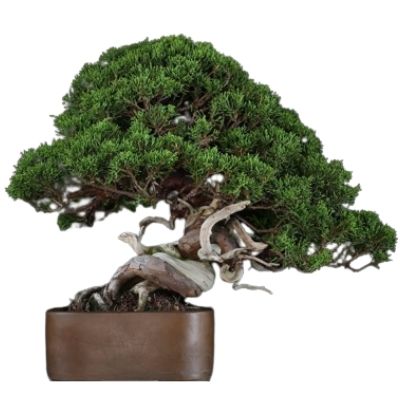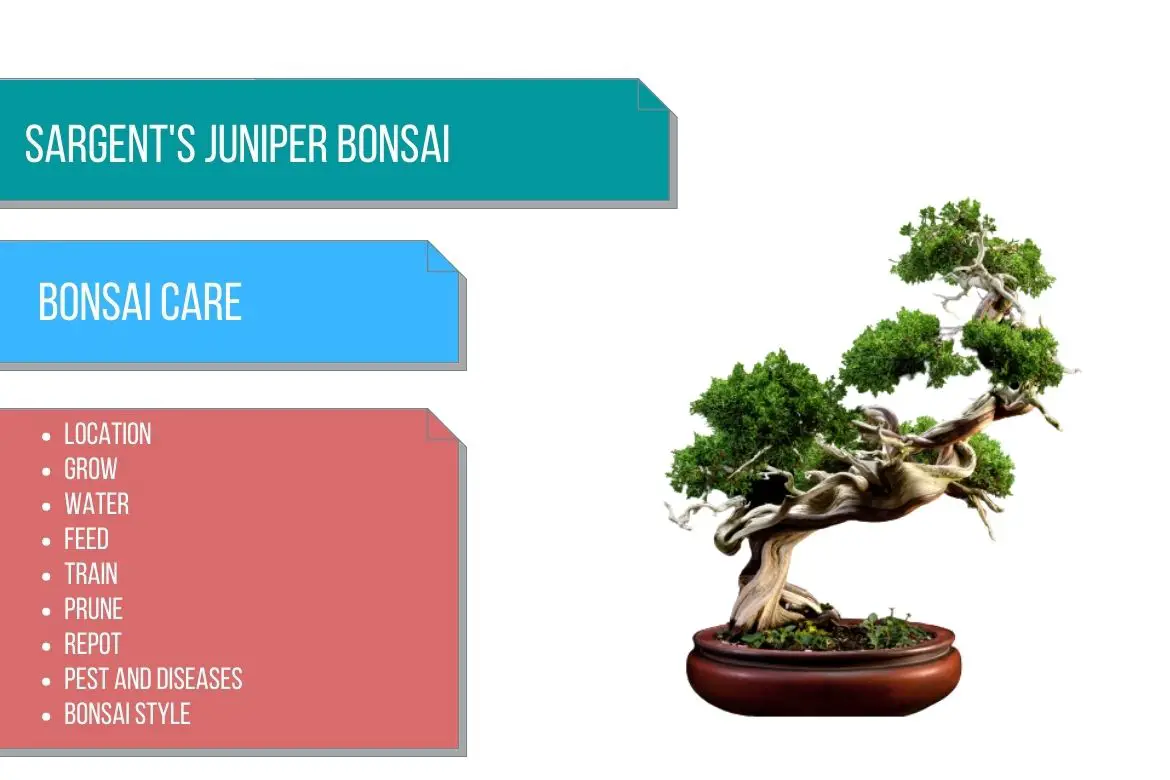
Sargent’s Juniper
(Juniperus chinensis Sargentii)
Country of Origin : Japan
Bonsai Styles : All the bonsai styles except broom style
Zone : 5 – 9
Sargents juniper bonsai tree is the Japanese variety of the Chinese juniper bonsai tree.
It is also known as shimpaku.
As a semi-prostrate shrub, this juniper grows in rocky mountainous and coastal areas in its native Japan.
Scaly foliage is bright green in adult form, while the shaggy bark is an attractive reddish brown.
The trunk and branches are very flexible and are not damaged when bent.
Naturally, the foliage pads produce smooth, rolling curves that resemble cloud-like silhouettes.
Sargent juniper is one of the easiest tree species to make bonsai tree. Also, tree specimens collected from the wild make striking and stunning bonsai.
Best location to keep Sargent Juniper Bonsai
Pretty much the same principals of Chinese Juniper (Juniperus chinensis bonsai tree) applies to sargents juniper bonsai tree.
The foliage of Junipers grows neatly and compactly under full sun.
Sargent juniper bonsai tree also does well in semi shade.
Shade will also protect the bonsai tree from extreme cold and hot temperature variations.
In all temperate regions of Europe, the sargents juniper bonsai tree does not require special protection in winter.
However, they should not be considered hardy in North America. It is advisable to move tree into a frost-free shed during winter when temperatures drop below 14°F (-10°C).
A good temperature range for sargent bonsai tree to grow is 20 – 90°F (-6 to 32°C)
Provide protection from hard frosts, which cause the foliage to turn a bronze color until spring comes. In spring the foliage will come back to its green color.
Refer sunlight requirements for indoor plants for more indoor plant placement ideas.
Propagation of Sargent Juniper
It can also be propagated anytime using softwood cuttings.
Watering Sargent Juniper Bonsai
You should water your sargents juniper bonsai tree daily during the growing season. Spray mist on the foliage in the summer.
In winter, keep the soil moist so that the foliage is not dried out by the freezing winds.
Do not allow the soil to become waterlogged and do not let it completely dry out.
Wiring Sargent Juniper Bonsai
Sargents juniper bonsai can be wired any time.
Do not leave the wires on the branches for more than a year.
Pruning Sargent Juniper Bonsai
When to prune Sargent juniper bonsai?
How to prune Sargent juniper bonsai?
Whenever trying to prune Sargent juniper bonsai tree, make sure not to prune too hard. By pruning too hard, you will encourage the growth of young needle like shoots.
In case you are trying to reshape the bonsai tree, the woody growth should be cut back, however be careful not to cut through the foliage since this will brown the tips.
The main goal of pruning Sargents juniper bonsai tree is to keep the foliage structure compact and dense. To achieve this, make sure not to let the young shoots to grow longer than needed.
The extending older shoots can be identified by their thicker structure and lighter color. Prune them back to the first small sized shoot towards the end of the growing season.
This facilitates the penetration of light and air in the inner areas and leads to new growth at branch intersections.
Pinching Sargent Juniper Bonsai
To keep a neat outline, pinch down all the growing tips with your fingers.
To cut back or remove aggressive extension shoots, they should be cut as close to a healthy side shoot as possible.
Make sure the undersides of branches are free of foliage.
Repotting Sargent Juniper Bonsai
When to repot Sargent juniper bonsai?
Repotting of a Sargents bonsai tree can be done at any time of the year.
However do it preferably in early spring and avoid repotting the tree in hottest month.
Repot sargents juniper bonsai tree every 2 years. However, when the tree becomes 10 years old, you can repot the sargents juniper bonsai tree every 5 years or so.
If the roots still have room to expand in the bonsai pot, do not repot the tree.
When repotting, do not prune more than 1/3 of the roots.
You can use a soil mix mixed with 20% finely chopped fresh sphagnum moss
OR
You can also use one part humus or peat, one part Akadama and two part coarse sand.
OR
You can also use equal parts of coarse sand, leaf mold and loam.
Must Read: Bonsai Soil Recipes
Must read : Choosing the right bonsai container
Feeding Sargent Juniper Bonsai
From the beginning of the growing season to mid-fall, apple fertilizer every two weeks.
Diseases and pest of Sargent Juniper Bonsai
Scaled insects can colonize the plant without being noticed. Yellowing of the foliage and minute white spots on the leaves are telltale signs.
Incorporate systemic insecticides into the bonsai soil.
Infections caused by fungi are rare in sargent juniper bonsai tree.
It is generally possible to remove aphids and scale insects with a jet of water, however if an infestation is severe apply a systemic insecticide.
Sargent Juniper bonsai care
The junipers turn yellow or brown when exposed to frost. While it is not aesthetically pleasing, it does not harm the tree.
The bonsai will turn green again when spring arrives.
In Japan, it is not uncommon to see juniper bonsai exhibits with wired branches.
Junipers shed their leaves on a regular basis in the wild in order to keep a balance between the efficiency of roots and the needs of leaves. This will also happen when the sargents juniper bonsai tree is in a bonsai container.
What to look for when buying Sargent Juniper Bonsai
Look for a tree which has series of curves. These curves should not have any acute and sharp bends. Sharp turns in the trunk does not look natural in sartgents juniper bonsai tree.

